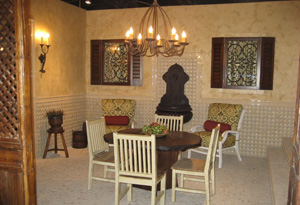Summer Space: Designing from the Inside Out

Frank's "Outdoor Tuscan Patio" design at DreamHome, 2009
Summer is finally upon us, which means we can't ignore the backyard or patio any longer! Luckily, I have a process that makes outdoor design a lot easier: Look at your exterior space and design it with the same principles with which you approach interior rooms. Try treating the natural environment as your own décor inspiration—it can help dictate color, texture and scale.
With outdoor space, more is better. There is no good reason to want less space to work with. Yet some people are overwhelmed by the size of a yard or patio and simply choose a corner to stick a grill and a bench, end of story. A better way to approach open space is to create zones, just like you would with social spaces indoors.
Creating Zones
Think first about what outdoor-only features you definitely want, such as a fire pit, a sheltered area, a walkway or patio, a fountain, a pool or a spot for lawn games like horseshoes and bocce. Essentially, anything that you've already placed in your outdoor space can be a center that you position seating and décor vignettes around. After those focal centers are determined, go about decorating and positioning as you would indoors. Don't be afraid to combine several seating and table vignettes into a larger social cluster.
Having trouble envisioning your outdoor zones? Try using rope, tape, washable outdoor spray-paint or sticks to lay out squares that will help you envision how your zones will fit and come together.
The function of your outdoor design should be to facilitate the same ease and comfort as the coziest place inside your home. You will also be able to add features that cannot exist inside. If you think of an outdoor space as a room equal in status to your living room, you'll automatically start to come up with ways to ease the transition between indoors and out. If you can design a space that, on a nice day, makes the door between indoors and out seem as minor as a door between a kitchen and living room, then you've designed a successful outdoor space!
Get Frank's dos and don'ts of outdoor design
With outdoor space, more is better. There is no good reason to want less space to work with. Yet some people are overwhelmed by the size of a yard or patio and simply choose a corner to stick a grill and a bench, end of story. A better way to approach open space is to create zones, just like you would with social spaces indoors.
Creating Zones
Think first about what outdoor-only features you definitely want, such as a fire pit, a sheltered area, a walkway or patio, a fountain, a pool or a spot for lawn games like horseshoes and bocce. Essentially, anything that you've already placed in your outdoor space can be a center that you position seating and décor vignettes around. After those focal centers are determined, go about decorating and positioning as you would indoors. Don't be afraid to combine several seating and table vignettes into a larger social cluster.
Having trouble envisioning your outdoor zones? Try using rope, tape, washable outdoor spray-paint or sticks to lay out squares that will help you envision how your zones will fit and come together.
The function of your outdoor design should be to facilitate the same ease and comfort as the coziest place inside your home. You will also be able to add features that cannot exist inside. If you think of an outdoor space as a room equal in status to your living room, you'll automatically start to come up with ways to ease the transition between indoors and out. If you can design a space that, on a nice day, makes the door between indoors and out seem as minor as a door between a kitchen and living room, then you've designed a successful outdoor space!
Get Frank's dos and don'ts of outdoor design
Do...
Don't...
- Carry indoor design techniques to your outdoor project.
- Install some manner of outdoor shelter—even the cheapest will serve you for several seasons.
- Envision your outdoor space as a series of comfortable and functional zones.
- Make the most of possibilities like fire and water that are rarely possible indoors.
Don't...
- Treat your outdoor space as inherently less comfortable than your indoor spaces.
- Think that a lack of temperate weather year-round means it's not worth designing a wonderful outdoor space.
- Underestimate flower gardens as anything less than the most satisfying décor there is.
- Think an urban outdoor space is not worth decorating.
More from Frank Fontana






